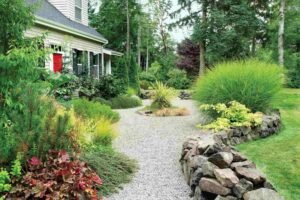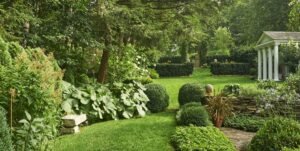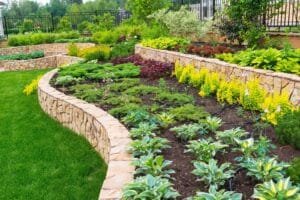Hardscaping refers to installing non-living, artificial elements in a landscape design, such as patios, retaining walls, walkways, and other outdoor features. Hardscaping provides a functional and aesthetic structure to outdoor spaces. It can also increase property value and offer solutions to challenges such as erosion control and water drainage. The process of Hardscape installation typically involves the following steps:
- Design Planning: A plan that considers the property’s layout, existing features, and the client’s vision and requirements are created.
- Site Preparation: The site is prepared by removing existing vegetation, grading the ground, and compacting the soil.
- Material Selection: The materials for the hardscape elements, such as pavers, stones, or concrete, are selected based on the design plan and budget.
- Installation: The hardscape elements are installed according to the design plan, including laying the foundation, setting the materials, and making any necessary cuts or adjustments.
- Finishing: The hardscape elements are finished with details such as edging, sealing, and filling gaps.
- Maintenance: Regular maintenance is recommended to ensure the hardscape installation lasts for years. Maintenance may include cleaning, sealing, and fixing any damages.
Overall, hardscape installation is a complex process that requires careful planning, proper preparation, and professional execution.
What Is Hardscape?
Hardscape is a type of landscaping that involves installing hard materials such as stone, brick, or concrete to create a defined outdoor space. It is used to add structure and definition to an outdoor area and can create paths, patios, walkways, and more. These materials provide a more permanent form than that natural landscaping, making it easier to maintain the area over time. It also provides a more visually appealing look to the site and can be used to create a more formal or structured outdoor living space.
Hardscape Vs. Landscape
Hardscape refers to any hard surfaces in the environment, such as walkways, patios, stone walls, and decks, while landscape refers to any living elements in the background, such as plants, trees, and grass. Hardscape is defined as a man-made structure and definition in the overall landscape, while the landscape is defined as the more natural or living elements within an outdoor area.
Advantages Of Hardscape
Hardscape is a great way to add a unique and aesthetically pleasing look to your outdoor space. Hardscapes create pathways and walkways, allowing you to utilize the space better. In addition, hardscaping can help to reduce maintenance costs by reducing the need to mow or weed the area. Hardscape is also a great way to create a barrier between different areas of your outdoor space, helping to keep your plants and flowers safe from foot traffic. Hardscaping can also help reduce soil erosion and promote water drainage, making your outdoor space more sustainable.
Disadvantages Of Hardscape
Hardscape can be expensive to install and maintain, and it cannot be easy sustainably. Additionally, it can be challenging to change the hardscape once installed, and it can disrupt the natural habitat of local wildlife. Hardscape materials, such as concrete and stone, are challenging to break down and reuse, so once installed, they are usually there to stay. Additionally, they can block natural water flow, cause soil erosion, and disrupt the habitats of insects and other wildlife.
Advantages Of Landscape
Landscaping can improve the aesthetic appeal of a home and increase its overall value. It also helps to reduce energy costs by providing shade and insulation and improving air quality by reducing erosion and runoff. Landscaping can also help divert rainwater away from home, preventing water damage and attracting beneficial wildlife, such as birds and pollinators, that can help keep the garden healthy.
Disadvantages Of Landscape
One disadvantage of the landscape is that it requires a large amount of space. This can be problematic for people living in urban areas or with limited outdoor space. Also, landscapes require much maintenance and can be expensive. This is because landscaping often requires large plants and trees, which can be costly and require routine care and attention. Additionally, zoning restrictions may limit what can be planted or constructed in an urban area.
Hardscape Examples
Hardscape examples include driveways, patios, retaining walls, decks, walkways, stairways, and ponds. These elements are designed to enhance a property’s landscape and provide functionality. Hardscaping features are typically made of stone, brick, wood, or concrete and can create focal points, add structure, and create a more aesthetically pleasing landscape. They also help improve drainage and provide seating, storage, and other practical purposes.
Hardscape And Softcape
Hardscape refers to the complex elements of a garden, such as pathways, decks, walls, and other built structures, while soft scape refers to the more delicate elements, such as plants, trees, and grass. Together, they create a balanced and attractive garden. The hardscape elements provide structure and visual impact, while the soft scape elements provide texture and color. Together, they create a unified outdoor space that is both aesthetically pleasing and functional.
Hardscape Lighting
Hardscape lighting is a type of outdoor lighting system used to accentuate the architectural features of a home or landscape. It is usually installed in the ground around the perimeter of a structure or along walkways and pathways. It can be used to create a dramatic effect or to provide light for safety and security. Hardscape lighting is typically made up of low-voltage lights hidden underground, allowing them to stay out of sight and give a softer, more natural lighting effect. The lighting is usually installed in a pattern and can highlight certain property features, such as trees, shrubs, and garden beds.
Conclusion:
Hardscape installation can significantly add value to a property while making it look attractive and appealing. It can also save money on maintenance costs in the long run. With careful planning and suitable materials, hardscape installation can be an excellent investment for property owners. Explore Landscaping specializes in hardscape services. Hardscaping adds structure and low-maintenance elements to your outdoor space, such as pathways, patios, retaining walls, and other features. These features can be designed to complement the existing landscape and increase the property’s aesthetic appeal while also improving its functionality and reducing future maintenance costs.







